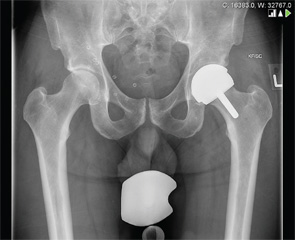The patient underwent resurfacing of the acetabulum and femoral head two months later. The patient in this case had a posterolateral approach, and the surgeon used the Birmingham hip resurfacing system (see Figure 2).


Outcomes
The patient received short-term home PT following surgery. Home PT focused on improving function within the home, as well as improvement of hip motion and increasing strength. The patient was avid about completing his strengthening and stretching therapeutic exercises. In addition, the patient invested in a recumbent bike and used it six days a week to help improve his hip ROM and maintain cardiovascular fitness.
Following home PT, the patient completed two months of outpatient PT. On examination, the patient had moderate pain levels with activity, a positive antalgic gait, moderate soft tissue restrictions, 105° of hip flexion and 0° of hip extension. The patient’s goals were to walk without pain and, eventually, to return to high-level activities, such as running, road biking and weight lifting. The patient’s PT goals included decreasing pain, improving ROM, increasing strength, normalizing gait and returning to his premorbid level of function. The patient’s outpatient PT consisted of progressive therapeutic strengthening and stretching, soft tissue and scar mobilization, and aerobic conditioning on a stationary bike. He was discharged with 120° left hip flexion and left hip strength of 4+/5. He had no pain during ADLs and was able to gradually progress to running independently without pain or gait deviation.
At a four-year postoperative follow-up, he reported no hip pain during ADLs, elliptical or weight training, or using free and machine weights. The patient had recently completed a 5 km race with a time of 33 minutes, without hip pain. He was very satisfied with his postoperative function and activity levels.
Discussion
HR is an alternative to THA for a select group of patients.1 With appropriate postoperative rehabilitation, this procedure allows younger, more active patients to return to athletic activities and high-impact sports.5 THA and HR differ in the amount of bone removed and the amount of joint stability following the procedure.
In an HR procedure, the femoral neck is preserved, allowing patients the potential to return to high-level activity due to intrinsic bone stability.1 In addition, the bone conservation of the femoral neck allows conversion to THA when indicated in aging patients.6 HR restores physiologic motion and normal gait and has a greater likelihood of maintaining normal leg length compared to THA.6,7

